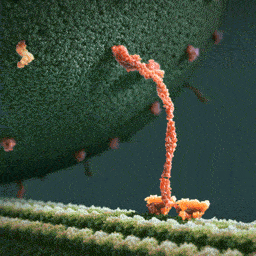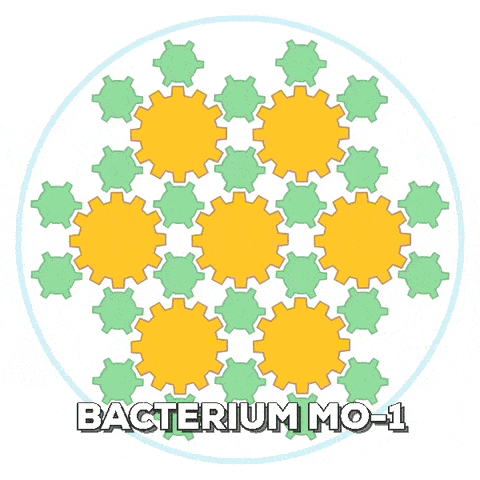(Originally posted September of 2013)
NANOTECHNOLOGY
Gears, Motors, and “Cogs”
How does [chance] selection arrive at such coordination? What good is one gear without the corresponding gear? The challenge of IC [irreducible complexity] for Darwinism remains. ~ Uncommon Descent
Mechanical gears – like those found in clocks – have been around since the Greeks are thought to have invented them around 300 B.C. But scientists have now discovered a small hopping insect equipped with a set of living gears! University of Cambridge biologists discovered that Issus coleoptratus have an intricate gearing system that locks their back legs together. This allows both legs to spring at the exact same instant, propelling the tiny creatures straight forward. If one of the bug’s legs jumped a fraction of a second earlier than the other, this would push the insect off course to the left or right. The gears are located at the top of the insects’ hind legs and include 10 to 12 tapered teeth. The teeth of the gear lock together neatly, and they even have curves at the base, a design incorporated into man-made mechanical gears to reduce wear over time. Researcher Gregory Sutton said, “We usually think of gears as something that we see in human-designed machinery…. These gears are not designed; they are evolved – representing high speed and precision machinery evolved for synchronisation in the animal world.” What we’d like to ask him is how did this insect survive for thousands of years while it couldn’t jump straight? No, there is a much simpler explanation that scientists might see if they weren’t so biased against a Creator. The gears were designed by God, who gave all of His creatures – including you and me – all of the intricate parts we need!
Mind you, we have tiny motors (complete) found in nature that likewise fit Darwin’s own challenge of irreducible complexity — disproving neo-Darwinian positions… however, these gears provide yet another of many irreducible complexities that philosophical naturalism is hard-pressed to answer.
Atheist evangelist ~ Richard Dawkins ~ famous quip almost seems painfully funny:
- “Biology is the study of complicated things that give the appearance of having been designed for a purpose.” (See more here)
Here is another evidence of “irreducibilities” found in nanotechnology, the Kinesin Motor:
Via, EVOLUTION NEWS AND VIEWS:
One of the most amazing examples of cellular nanotechnology is a molecular motor protein known as kinesin. Kinesin is responsible for transporting molecular cargo — including chromosomes (e.g. during cell division), neurotransmitters and other important material — along microtubule tracks from one region of the cell to another. It is driven by ATP hydrolysis, thereby converting chemical energy into mechanical energy which it can use for movement. A kinesin molecule typically possesses two tails on one end, which attach to the cargo, in addition to two globular heads (often called “motor domains”) on the other end. Some readers may recognize this elegant protein from the now-famous Harvard animation, Inner Life of the Cell (time 1:59).
The sheer number of processes needed to be undertaken by such a motor protein makes the appearance of intelligent design seem almost beyond rational denial. Of course, many people resist this conclusion despite the evidence. As one Science Daily article in October 2010 put it,
“Our results show that a molecular motor must take on a large number of functions over and above simple transport, if it wants to operate successfully in a cell,” says Professor Matthias Rief from the Physics Department of the TU Muenchen. It must be possible to switch the motor on and off, and it must be able to accept a load needed at a specific location and hand it over at the destination. “It is impressive how nature manages to combine all of these functions in one molecule,” Rief says. “In this respect it is still far superior to all the efforts of modern nanotechnology and serves as a great example to us all.” [emphasis added]….
The General Theory of Evolution contends that every lifeform on Earth came about by non-purposeful, unintelligent accidents. Yet many evolutionists repeatedly refer to seeing amazing design in nature. But can design exist without a designer? Join Eric Lyons as he looks at the remarkable design we see, even down to the smallest creatures on Earth, all of which point to a Grand Designer.
Information drives the development of life. But what is the source of that information? Could it have been produced by an unguided Darwinian evolutionary process? Or did it require intelligent design? The Information Enigma is a fascinating 21-minute documentary that probes the mystery of biological information, the challenge it poses to orthodox Darwinian theory, and the reason it points to intelligent design. The video features Dr. Stephen Meyer, and molecular biologist Douglas Axe, founder of the Biologic Institute. For more about intelligent design theory be sure to visit “Intelligent Design: The Definitive Source on Intelligent Design“
If you watch the short videos below, keep in mind that all this complexity at the cellular/protein level needs to be up and running optimally for life to have happened… at all.
And what one should keep in mind is the time-factor in all this “evolution” involved in event the simplest working protein… even long time (billions of years) is not enough time to get “the show on the road” ~ see Not Enough Evolutionary Time.
The idea that Behe’s flagellum motor has been answered is wishful thinking at best, and corrupt science at it’s worst (scientism: which is an insertion of a metaphysical principle stating things like “the only quantifiable reality known is the one made up of atoms, and, science [thus defined] is the best means to understanding said reality”). Really, then, it is an “evolution-of-the-gaps” type thinking.
✿ Ken Miller’s challenge can be read here;
✿ Responses to it and derivatives to it can be found here.
But as one can see… these giants of I.D. did truly wipe the floor with their critics [full exchange].
By-the-way, all this just got WAY MORE complex. For instance, here is the fast-swimming magnetotactic bacterium MO-1… it has 7-flagellum motors… with counter gears:
Here is a basic animation:
One should see Malcolm Bowden’s presentation on YouTube of the bacterium MO-1 as well.
And NOW even more complex is the fact that quantum mechanics may play a role (unrelated to the DNA or RNA) that folds these proteins into the shape for pieces to the whole of the working part.


